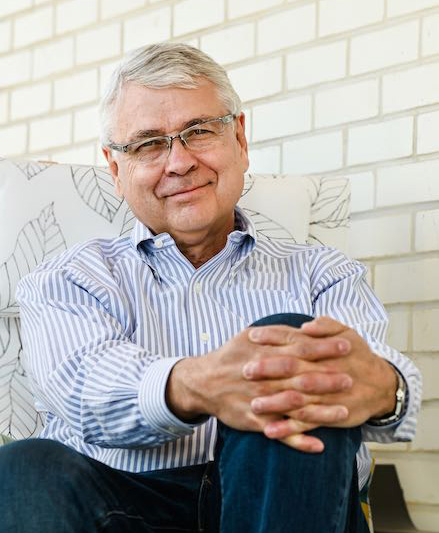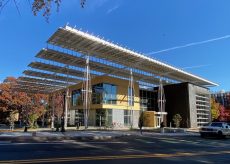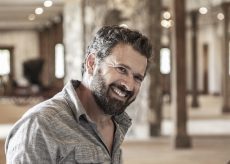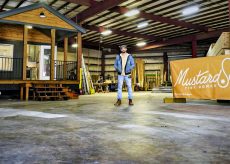Net-zero and Healthy: Thrive Home Builders deliver the goods


Gene Myers, founder & CEO of Thrive Home Builders in Denver, Colorado, has been on the leading edge of performance home building for nearly 30 years. In 2013, Gene decided that building homes that are healthy for the planet wasn’t enough anymore. He needed to be building homes that were healthy for his customers, too. In the eight years since, Thrive Home Builders has received a long list of honors and awards for their continued commitment to innovation, ability to dissect and anticipate consumer behavior and drive to shift industry norms and practices.
We reached out to him recently to get the latest on Thrive, its changing focus from energy efficiency to occupant health, the impacts from COVID, and what he sees as the future for both Thrive and the industry.
PGH: Gene, we’re here at your latest project, a mixed-use community you refer to as Central Park… and this is your own house?
GM: Have you ever seen “Arrested Development”? That’s my life right now, living in a model home—down to the fake houseplants. I was living in a townhome, and I knew this house was too big, but this project was selling out fast and I really wanted to see if everything that we do works.
This house is net-zero—it has solar already installed, a sonnenCore home battery for energy storage and power arbitrage—and it’s everything we know how to do on health.

Of course, when we started doing health, everybody looked at me cross-eyed, but the world knows that health in a home is important now. I feel like the markets come around to a lot of the things that we do. From a climate standpoint, we believe that we’ve got to get fossil fuels out of our lives, so the house we’re about to go look at is all electric—but a lot of people can’t even imagine that. They think, “That must be some strange house.” But it’s beautiful, appealing and has a lot of light.
I think there’s just a myth in the minds of consumers that, “if I’m going to do something sustainable, it entails sacrifice.” But that’s one of the big purposes of our models—to show that it does not entail sacrifice—that you can actually have a better quality of life, especially from a health standpoint.
When someone says, “Oh, I love this,” you know you’re about to sell a house, because it’s an emotional thing. It’s not really a rational buying decision. But once you’ve got their emotion, the rest of this—the performance aspect—is appealing to certain buyers, and that’s our market—a 35-year-old woman who drives a Prius, shops at Whole Foods and has Boulder-like tendencies. Or at least that’s been my half joke all these years.
PGH: In 2015, you rebranded as Thrive Home Builders and adjusted your marketing strategy from energy-efficiency to health. Has that caught on?
GM: Well, I’d say it’s been successful. When builders want to do something like this—usually, it starts with them just feeling like it’s the right thing to do—they run into this messy problem: You have to have a viable business model, too.
Back in 2015, you could see the writing on the wall that energy codes are going to evolve, and that at some point our competitive advantage just on energy efficiency was going to shrink. If that’s your product differentiation and your business model, then what?
Denver has a goal of all net-zero new home construction by 2024. That’s tomorrow. It’s not going to matter if you’re in DOE Zero Energy Ready because code is going to require everybody to do that. So, in 2015, I was thinking the next big thing is going to be health.
I think that what we learned trying to sell energy efficiency was that you have to explain why the buyer should care. There are multiple ways of doing it. One of them is financial—we’ll save you dollars per month. It costs more to buy one of our houses, but the incremental house payment is about a third of the total savings. We can tell people that, starting in your first month of homeownership, your monthly outlay for your home, including energy, is less if you buy our more expensive home than if you buy somebody else’s condo.
You have to explain it. But you don’t have to explain to our 35-year-old woman how important health is, because she has taken it upon herself to be responsible for the health of the people she loves. She’s willing to try anything to get the peace of mind of knowing that she’s done all she can for the people she loves. That’s the driver.
We started promoting that back in 2015. I think last year—well, 2019—we were the Builder of the Year for the EPA Indoor airPLUS program, and in 2020. we received our fifth Leader Award.
PGH: And then the virus hits.
GM: Yes. And we’re ready. One of our homes has a whole-house HEPA filtration. We can literally filter out the coronavirus in that house. And yet we’ve got ample fresh air. Typically, the tighter we build for energy performance, the harder it is to make sure that that indoor air is going to be fresh and healthy for person who the lives there, but we’ve already learned all that.
We just opened up this new series called Vitality and sold out all the lots we had. We waited for more lots from the developer, closed on those at the end of December, and now we’re just clipping right along—and these are finishing at $800,000 houses.
PGH: Was there already a high demand before COVID, or did COVID stimulate an increase?
GM: COVID definitely stimulated an increase. There are some segments of population, and they could be hypochondriacs—they could be whatever—they’re constantly focused on health. That was there all along.
But now, it’s like, “Wait a minute. We’re in this house all day long, every day. We need it to function for us.” I think that’s part of what’s driving that runaway demand for new homes right now. You need multiple work or study places in homes, as well as multiple outdoor living spaces to be able to get out of the house for a bit or have your neighbor over without feeling like your threatening anybody’s health.
This fall was announced that Meritage Homes, a big national builder, is going to go 100 percent EPA Indoor airPLUS. I think they’re about 3,000 homes a year. So, all of this is starting to go mainstream, which is a good thing, and our job is to stay out ahead, which we’ve been able to do for a long time and makes it a lot more interesting.
PGH: Besides HEPA filtration, what else makes a “healthy” home? Building materials?
GM:It’s really two things: EPA’s Indoor airPLUS, and then CARB 2—the California Air Resources Board’s second-generation standard—basically, don’t build with bad materials. You’re looking for a certification on all the materials that you put into the house. That’s low emissions of formaldehyde, volatile organic compounds (VOCs), carcinogens—you know, bad stuff. Keep bad stuff out and properly ventilate.
Proper ventilation means adequate air changes in the house. The theory is that the house has a volume of air in it, and you want to turn it over with fresh air every so often based on occupancy in the house. We don’t know how many people are going to live in our houses, so we really assume that we’re going to have a packed house. That’s EPA Indoor airPLUS.
But, in Colorado, the Rocky Mountains are over there, and then they’re also under here, and they emit radon in a pretty big way—so all of our houses have active radon mitigation. That’s not commonly done Colorado, but something like 21,000 people a year die of radon poisoning. It’s the second leading cause of lung cancer, behind smoking. You could be a nonsmoker in Colorado and die of lung cancer because you had radon in the house.
Then, there’s proper cooktop ventilation. While most researchers have had the alarm bells ringing on formaldehyde, the researchers at Lawrence Berkeley National Lab have decided that of more significance than formaldehyde is what they call PM 2.5—particle matter, 2.5 microns or smaller. Regardless of what it is, your lungs can’t filter it out. It goes straight into the bloodstream, and it’s carcinogenic. You can get PM 2.5 from your cooktop—from the open flame—or even on an induction, just from the sizzling of your food.
We also have another local problem here: ozone pollution. On a hot summer day, when we have an ozone alert—and we get more alerts in the summer—truth is, you should not be bringing that fresh air into your house unless you bring it through an activated carbon filter. We just found a source for activated carbon media for filtration, so now we’re doing that as well in this Vitality series.
The Health Department isn’t educating people about this because they still have figure out what to do about it. It’s kind of like the mask issue at the beginning of COVID. They don’t want to create hysteria, but if you look at the effects of ozone, it’s bad. Our view is that if it’s serious enough, we should address it with our customers.
PGH: What all, then, constitutes a smart home?
GM: I think that’s an interesting question. The smart-home concept has been around for my entire career. An early promotion was by General Electric, with all of the appliances controlled through power receptacles. Boy, I’m glad I didn’t do any of that. It would be like having your whole house based on Betamax. You can’t even buy it anymore.
The question is today, with the technology we have today, what SHOULD a builder be doing to create a smart home?
We have decided that the best thing we can do is just provide a really large data pipe to the house—just really great connectivity—because the people who are going to drive home automation and smart homes are Apple and Google and people we really aren’t going to be able to keep up with.
Between 1.3 to 1.4 million houses were built in the country last year. Compare that to the 100 million houses that are in the existing housing stock. That’s where the innovation is going to happen—in products geared for the aftermarket and designed for existing homes, which means they’ll be wireless.
Having said that, we think there’s a smart way to do what we do, and that’s where we could compete with Google and Apple. We have a chance to put things behind the walls.
Look at this app on my phone. This is my house right now. This app is constantly monitoring radon, VOCs, carbon dioxide, humidity, temperature and pressure. It’s doing it in three different places: the basement, because that’s where radon’s a problem; the master bedroom, because I spend a lot of time up there; and in the stairwell, because the theory is that the air is turning over between the floors.
Let’s say that we want better indoor air quality. Well, what if, with this monitoring, that it didn’t just give you a note on your phone that says, “Hey, you’ve got a Radon problem today”? What if it then talked to the HVAC system, ventilated it and solved the problem? That’s what we want.

If we have this instantaneous live feed for indoor air quality, we want it to work like a thermostat does with temperature, where if any of these parameters—like if CO2 is out of range of what it should be—it kicks in the ERV – the energy recovery ventilator and brings me some fresh air so that I can dilute the CO2.
I have a similar dashboard for my solar, a similar dashboard for my battery. The bottom line is, I don’t really want another app. What I want is for it to just solve the problem. That’s our next step in smart. It’s not turning on a lamp. To be honest with you, light switches work really well—I don’t really feel like I need to manage my lighting with my phone.
I was sitting in the audience of this presentation at RESNET, and the Pacific Northwest National Lab was explaining a preliminary finding they had. Based on a sample of lived-in, high-performance homes in California, Colorado, Oregon and Washington—I think—where they went in after the fact and measured the air quality and energy use, they found that all these fancy HVAC systems aren’t necessarily providing better air.
In many cases, the equipment was never installed properly. Others, it was never maintained. In some, it was unplugged.
When you have an issue as a homeowner, if you call the heating contractor, they come and say, “Oh, you don’t need this thing.” Well, actually, that’s the fresh air system.
I was just sitting there, and I realized that we’ve made our houses better, but we’ve also made them much more complex. What if OUR customers are paying this premium for a better system and it’s not doing them any good? That concerns me.
PGH: Is that where this new warranty I’ve heard about comes into play?
GM: It’s in the very beginning stages. I’m thinking about it as a car warranty. Get a 50,000-mile warranty. That’s great, but you do have to take it into the dealer to get it maintained. You’ve got to get the oil changed. You’ve got to do the basic maintenance, or you void the warranty. This notion of us providing a maintenance contract is like taking your house to the dealer to protect your warranty and to protect your investment.
The goal here is to make sure that our house in year 10 is performing just as well as it did on day one—to provide an industry-leading warranty and maintenance contract. Just sign the warranty and maintenance agreement, and then we come into your house twice a year, make sure it’s performing how it should be and change all the filters.
It all starts with what warranty do they have. They have the warranty from us, but they also have the warranty from their manufacturer for all the equipment—whether it’s your refrigerator or your heat pump. We have a project going on already where for every house, we’re compiling all the serial numbers, registering the warranties, recording when they start and end, what all is included or excluded, and what’s the expected life of the equipment. At a minimum, we’ll be able to have that for our customers when they need it.
PGH: And you’re pretty certain that would work?
GM: We’re not. Nobody knows, for certain. I talked to a great all-things-green market-researcher named Suzanne Shelton. She said, “Gene, just go do it. I could sell you a study on this, but I’m not going to know anything either. Nobody’s going to know. Why don’t you just start doing it? Start it at $50 a month and see if people do that.”
I have this hunch that people would pay per month what they pay for their phones to maintain their house and protect their investment.
We’ve already started putting QR codes on every piece of equipment. Just hold your phone up. But we don’t think people are even doing that.

In my dreams—and we’re maybe not going to get there in my lifetime—there is one app to Thrive at.
On that app, you can check your dashboard for your solar. You can see what’s going on with your battery. You can access all the products in your house. Ideally, all of them are there. We get our customers to share the information about what’s going on in their homes, including energy usage. When we see a problem, we’re proactive and call them: “Something’s going on with your solar. We need to come out and check. We probably need to reboot it and reset it up with the power company, because you got no credit last month for your solar.”
PGH: How did you get into this?
GM: I’m a civil engineer by training, and I got in through land-development for builders. But I’m also an old Peace Corps volunteer. I always tell everybody I jumped to the dark side and started working for developers. But there really is a little idealism still in me that says I ought to make a difference. Of course, the world is a lot bigger, and its challenges are a lot tougher than I thought as a young Peace Corps volunteer. When you come back, you realize, “Oh, I didn’t change the world.” And then you get on with your life.
But how do you reconcile that youthful idealism with what you do for a living? I came to the conclusion that I might not be able to change the world, but that’s not an excuse to do nothing. I think that’s sort of the default for a lot of people—if a problem looks almost feudal, then it’s okay to do nothing—so I just adopted this theory that, “Well, what you should do, then, is all you can do. Don’t worry about what you can’t do. Just about what you can do.”
So, I’m a builder. What can I do? I can build the best houses. I can build the most energy-efficient houses in America, apparently. Who knew? We can keep pushing on innovation and we can keep leaning into what’s next and what needs to happen. I’m not going to change the world or save the climate, but I’m going to change the world for people who live in my houses—because they’re going to be healthier—and our homes are going to do their part, and even pay for their own energy.
We just keep trying to figure out as a builder, what else can we do? It turns out we can do a lot.
PGH: Are there any key suppliers or affiliates that you would like to highlight as having a significant working relationship with?
GM: Well, Panasonic has been a good long-term partner of ours. We’ve done a lot with them. They have a system called “Cosmos,” which is a prototype of the indoor air-quality sensor that drives the HVAC system. That prototype is installed in this house, but it’s not ready for primetime.
Our rater, I think, is one of the best in the country, Energy Logic. I say that because they are a rating firm that certifies other raters. They’re great at rating homes, but they’re also great at rating the raters. It’s like a self-audit that makes sure the fraud and bad ratings out there aren’t a huge problem.
Really, a rater is just a great collaborator. That’s always my advice to builders if they’re just trying to start off—find a great rater. They’re going to know what works in your climate zone and what the standard of practice is from all the builders—because they probably work for way more than one builder.
Ours is a one-stop-shop for a rater who knows everything about our house. They look at the design and give us a prospective rating based on the design parameters, but then they come into the homes during construction at different points and they literally test every one of them to make sure they comply. Having them test all of the houses, for me, is just another step of quality assurance, and I’ve always viewed a rater as coming in and verifying everything on a house as a way to help me sleep at night.
Tyvek is another one of those partners that we’ll probably always work with. I’m good friends with a public relations person there, and our rep told her that she needs to come to Denver and get some photos of our houses for their brochure. The execution is that good. I told her, the reason it’s that good is because your rep comes out and trains the crews whenever we ask. If we see a new crew show up, we stop everything and get them trained first. Honestly, I think they purposely cycle their crews through our jobs so they can get them trained.
We’ve stuck with a lot of our local trades for years. If you’re a new builder, or if you’re an existing builder and you want to start building to this level, you can’t do it without subs that will come along side you and grow with you. Having been at this for decades, we have a group of subs that like pushing the envelope with us, and it’s really a huge part of our ability to just raise the bar a little bit every year.



